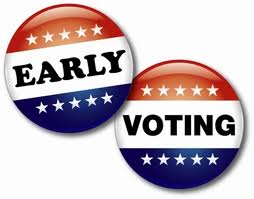This is the point in the early voting process where early voting hours expand, and as a result daily EV reports come in later. That may affect my ability to present the latest data each day, so I’m going to break the pattern today and engage in one of my favorite exercise, which is to use the data we have so far and make some wild guesses about where we may end up. Let’s take a look back at the first five days of early voting from the past elections we’ve been tracking, and see what fraction of the final EV total they were, and then how much of the complete vote was cast during the EV period. We begin with a table:
Year 5 Day EV Final EV 5 Day%
================================
2010 164,190 447,701 36.67%
2014 158,399 379,282 41.76%
2008 260,105 746,061 34.86%
2012 313,405 777,067 40.33%
2016 452,124 985,571 45.87%
I’ve separated the Presidential years from the non-Presidential years because we generally have very different electorates in each, and as such the behavior of one crowd may not be that predictive of the other. This year sure seems more like a Presidential year, so we’ll take all the numbers into account. The other factor, as you can see above, is that there has been a steady shift towards more and earlier early voting. Week 2 of early voting is always busier than Week 1, though that is becoming less the case. My guess is that we’ll see a pattern more like 2014 or 2016, but we can take a broader range of possibility into account:
380,266 at 35% = 1,086,474
380,266 at 40% = 950,665
380,266 at 45% = 845,035
380,266 at 50% = 760,532
I have a hard time believing we’ve already seen half of the early votes, but it’s possible. I think the third possibility, which would be approximately what we saw in 2016, is the most likely, though as with all things this year I hesitate to be too definitive. Note that outside of the last scenario, the early voting total will surpass the entire turnout for any off year in Harris County. The question here is not whether we’ll break records, it’s by how much.
The other side of this equation is projecting final turnout from EV turnout. We go once again to the historic data:
2016 = 73.61% early
2014 = 55.13% early
2012 = 64.53% early
2010 = 56.03% early
2008 = 62.76% early
Again we see a distinction between the Presidential and non-Presidential years, and again we see a trend towards more of the vote being cast early, 2014 notwithstanding. So again, we consider a range of possibilties:
760,532 at 75% = 1,014,082
845,035 at 75% = 1,126,713
950,665 at 75% = 1,267,553
1,086,474 at 75% = 1,448,632
760,532 at 65% = 1,170,049
845,035 at 65% = 1,300,053
950,665 at 65% = 1,462,561
1,086,474 at 65% = 1,671,498
I’m basically assuming this will be more like a Presidential year in terms of when people vote. It makes no sense to me that we’ll have nearly half the vote cast on November 6, so I’m not going to calculate a 55% scenario. Even with the most conservative projections, we’re on pace to top one million, and beating past Presidential years is within range. Final turnout in 2008 was 1,188,731, and it is certainly possible we could top that. I have a hard time wrapping my mind around the idea that 2016’s mark of 1,338,898 could be exceeded, but I can’t rule it out. Ask me again after early voting is done. Like I said, it’s not a question of whether we’ll break records, but by how much.
UPDATE: The Saturday EV totals came in a bit before 9. Google Drive is being unresponsive so I can’t give you a link, but I can tell you there were 8,646 mail ballots received, 79,641 in person votes cast, and the overall total is up to 468,549, which is more than the entire EV turnout of 2010. As the man once said, hold onto your butts.


Pingback: Early voting, Day 8: On to Week 2 – Off the Kuff